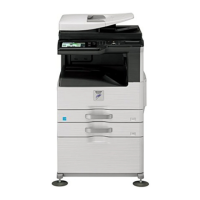




Do you have a question about the Sharp MX-M264N and is the answer not in the manual?
| Brand | Sharp |
|---|---|
| Model | MX-M264N |
| Category | All in One Printer |
| Language | English |
Provides an overview of the machine's external and internal components, including the ADF and operation panel.
Explains the functions of the operation panel, touch panel, and associated keys like HOME, JOB STATUS, SYSTEM SETTINGS.
Details how to turn the machine on/off and explains energy saving functions like Preheat and Auto Power Shut-Off.
Covers procedures for user authentication, including by user number or login name/password.
Explains how to load paper into various trays and the bypass tray, and how to place originals for scanning.
Describes optional devices like paper drawers, job separators, and finishers, including their functions.
Provides instructions for regular cleaning of the machine, including the document glass and rollers.
Explains how to use the touch panel and external keyboard for entering text, including functions of main keys.
Outlines the fundamental steps for making copies, including using the ADF and document glass.
Details how to adjust exposure, original type, resolution, and other image settings for better copy quality.
Explains paper selection, tray settings, and handling paper that cannot be used.
Covers advanced copy functions like Margin Shift, Erase, Dual Page Copy, Pamphlet Copy, and Job Build.
Explains how to perform basic printing from Windows and Macintosh environments.
Details specific print functions like printing on different paper, using inserts, and carbon copies.
Covers rotating images, enlarging/reducing print size (Zoom/XY-Zoom), and mirror image.
Explains direct printing from the machine via FTP, USB memory, or network folders.
Guides users on how to check job status, spool screen, and completed jobs.
Covers essential setup steps like connecting the telephone line and checking power.
Explains the main interface and keys used in fax mode, including address book access.
Outlines the basic steps for sending a fax, from placing originals to starting transmission.
Details methods for entering fax numbers, using the address book, search numbers, and global address books.
Explains different transmission modes like memory transmission, direct transmission, and handling busy lines or errors.
Covers adjustments for scanning originals, including size, exposure, resolution, and file format.
Explains how to preview the scanned image before sending the fax.
Provides information on checking the status of fax jobs, including job queue and completed jobs.
Lists technical specifications for the facsimile function, including resolution, speed, and supported paper sizes.
Covers initial preparations and settings for network scanning, including power and sender information.
Explains the main interface and keys for different scan modes like Scan to E-mail, FTP, Desktop, and Network Folder.
Outlines the basic steps for scanning and transmitting images, including destination and settings selection.
Details how to specify destinations for scanning, using address books, search numbers, and manual entry.
Explains various image transmission methods like Scan to E-mail, FTP, USB Memory, and Internet Fax.
Covers adjustments for scanning originals, including size, exposure, resolution, file format, and color mode.
Explains how to preview the scanned image before sending it.
Details advanced scanning features like Erase, Dual Page Scan, Card Shot, Job Build, and Slow Scan Mode.
Provides an overview of document filing, its uses, and different saving methods (Quick File, File, Scan to HDD).
Explains how to save files using Quick File, File, and Scan to HDD functions.
Details the procedure for scanning a document directly to the machine's hard drive.
Covers retrieving, printing, sending, moving, deleting, and managing stored files.
Guides users on how to select a file from the folder selection screen for operations.
Details the options available for configuring jobs after selecting a stored file, such as printing or sending.
Explains how to print files that have been saved using the document filing function.
Details how to send stored files via fax, Internet fax, or scan send.
Explains how to change file properties like Sharing, Protect, and Confidential.
Provides instructions on how to delete files that are no longer needed.
Guides users on how to search for files and folders using various criteria like user name or file name.
Explains general interface elements and operations common across system settings.
Covers settings configurable by general users, including date/time, paper trays, and address book.
Details specific settings for fax functions, including reception, forwarding, and transmission controls.
Covers settings requiring administrator privileges, such as user control, network, and security settings.
Addresses common user queries and basic operational issues.
Provides step-by-step instructions for clearing paper jams in various machine locations and the finisher.
Lists common issues with copy operation and results, offering troubleshooting steps.
Addresses issues with printing operation and results, including connectivity and driver problems.
Covers common problems encountered during fax transmission and reception.
Addresses issues encountered during scanning and Internet fax operations.
Details issues related to saving, managing, and retrieving files using the document filing function.
Covers miscellaneous operational issues like touch panel problems, login issues, and general malfunctions.
